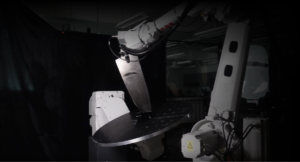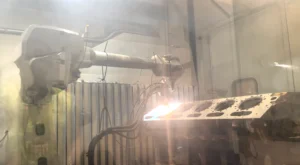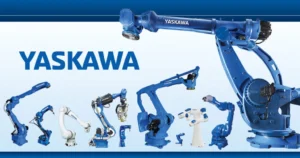table of contents
- Heading 1
- Heading 1
- Heading 1
- What Is Automotive Welding?
- How Does a Technician Use Automotive Welding?
- Essential Tools for Automotive Welding
- Types of Welding in Automotive Industry
- Automotive Welding Processes
- Manual Welding in the Automotive Industry
- Common Techniques and Applications
- Manual vs Robotic Welding in the Automotive Industry
- Innovations in Automotive Welding: Vision-Guided Robotic Welding
- Conclusion
- FAQs on Automotive Welding
share this
Welding is far more than just joining two pieces of metal. It’s a science that demands precision, expertise, and a deep understanding of materials and techniques. In industries like automotive manufacturing, where safety and performance are critical, even a minor mistake can have significant consequences. This blog delves into automotive welding, exploring its intricacies, processes, essential tools, and benefits.
What Is Automotive Welding?
Automotive welding is about joining vehicle parts to ensure they are strong and safe. It uses techniques for constructing, repairing, and customizing vehicles with metals like steel and aluminum. These welds need to withstand significant stress and impact, requiring skilled and accurate welders. But it’s not just about welding cars; it’s about ensuring safety, performance, and reliability. The quality of the welds directly impacts the vehicle’s crashworthiness and integrity. Welders must understand how different metals react under heat and pressure to choose the right technique for each part, whether it’s the body, frame, or exhaust system.
How Does a Technician Use Automotive Welding?
Your technician uses automotive welding to perform tasks like repairing damaged body panels and fabricating custom components. The process starts with an assessment, analyzing the vehicle to determine the needed repair or fabrication. This involves interpreting blueprints, factory diagrams, and technical manuals for exact specifications.
Once the plan is in place, the technician selects the appropriate welding method and equipment. Common techniques in automotive applications include MIG (Metal Inert Gas) welding, TIG (Tungsten Inert Gas) welding, and spot welding. We’ll cover these types later in this blog. Each technique has its advantages, chosen based on the metal type and job requirements. For example, MIG welding is known for its speed and versatility, while TIG welding is preferred for precision and a clean finish.
The actual welding process requires steady hands and a keen eye for detail. Your welder must maintain the correct temperature and pressure for a strong, durable bond without warping the metal. Safety is also critical, so welders wear protective gear like helmets, gloves, and aprons to shield themselves from sparks, heat, and UV radiation.
Essential Tools for Automotive Welding
The right tools are essential for successful and safe automotive body welding. Here’s a rundown of the must-have tools for any automotive welder:
- Welding Machine: The type of welding machine used depends on the specific welding process. MIG and TIG welders are commonly used in automotive applications due to their versatility and precision.
- Welding Helmet: Protects the welder’s eyes and face from sparks, heat, and harmful UV rays. Auto-darkening helmets are particularly useful as they provide better visibility and protection.
- Welding Gloves: Essential for protecting hands from heat and sparks. These gloves must be durable and comfortable to allow for dexterity.
- Angle Grinder: Used for preparing and finishing welded joints. It helps in smoothing out the welds and removing any excess material.
- Clamps and Magnets: These tools are crucial for holding metal parts in place during the welding process.
- Wire Brush: Used to clean the metal surfaces before welding for a clean and strong weld.
- Chipping Hammers: Used to remove weld slags and spatters.
Types of Welding in Automotive Industry
The automotive industry utilizes various welding techniques to meet the diverse needs of vehicle manufacturing and repair. The most common types are as follows:
Spot Welding
Spot welding is a resistance welding process. This is used to join two or more sheets of metal by applying pressure and heat at specific points. This technique is particularly effective for assembling body panels and other sheet metal components in automotive manufacturing.
Here’s how it works:
The automotive industry utilizes various welding techniques to meet the diverse needs of vehicle manufacturing and repair. The most common types are as follows:
Applications:
- Joining thin sheets of metal
- Welding car parts like bodies, doors, and hoods
- High-volume production tasks
Advantages:
- Strong, reliable joints
- Minimal distortion
- Requires no filler material or gasses
- Produces minimal waste
- Quick succession of welds
- Cost-effective
MIG Welding
The MIG (Metal Inert Gas) welding process is also called Gas Metal Arc Welding (GMAW). It is a versatile and widely used technique in the automotive industry. It involves feeding a continuous wire electrode through a welding gun, which melts and joins the metal pieces.
Here’s how it works:
The MIG welding gun is connected to a wire feeder and a gas cylinder (usually a mixture of argon and carbon dioxide). When the trigger is pulled, the wire feeds through the gun, creating an electric arc that melts the wire and the base metal. The inert gas shields the weld from contaminants in the air.
Applications:
- Body repairs
- Frame construction
- Welding various metals, including steel and aluminum
Advantages:
- High welding speed
- Easy to use
- Produces clean, high-quality welds
- Minimal spatter
- Long, uninterrupted welds
TIG Welding
TIG (Tungsten Inert Gas) welding is also known as Gas Tungsten Arc Welding (GTAW). It is a precision welding process that uses a non-consumable tungsten electrode to create an arc.
Here’s how it works:
TIG welding involves creating an arc between a tungsten electrode and the workpiece. The welder can use a filler rod, if necessary, to add material to the weld joint. An inert gas (typically argon) flows around the tungsten electrode. This protects the weld from contamination.
Applications:
- Welding non-ferrous metals (aluminum, magnesium)
- Thin sections of stainless steel
- Exhaust systems
- Engine components
- Custom fabrication work
Advantages:
- Clean, high-quality welds
- Excellent aesthetic appearance
- Superior control over the weld bead
- Ideal for intricate welding tasks
- Unmatched quality and precision
Each of these welding techniques has its unique strengths and applications, making them essential tools in the automotive industry. Understanding these methods helps automotive professionals choose the right technique for each specific application.
Automotive Welding Processes
Several welding processes are used in the automotive industry, each suited for different applications and types of metals. MIG welding is one of the most popular welding techniques in the automotive industry due to its versatility and ease of use. Here’s a step-by-step guide on how Auto MIG welding is performed:
Preparation:
- Safety Gear: Before starting, the welder puts on protective gear, including a welding helmet, gloves, and a welding jacket to protect against sparks and UV radiation.
- Workspace Setup: Ensure the workspace is clean and free of flammable materials. Secure the workpiece using clamps or magnets to keep it steady during welding.
- Equipment Check: Inspect the MIG welder, ensuring the gas cylinder is filled, and the welding wire is properly loaded into the machine.
Setting Up the Welder:
- Gas Selection: Typically, a mix of argon and carbon dioxide is used if the metal involved is steel. The gas flow rate is set according to the welder’s specifications.
- Wire Feed Speed and Voltage: The welder adjusts the wire feed speed and voltage settings on the MIG welder based on the thickness of the metal being welded. However, they are allowed to use these settings on the actual workpiece only after testing on a scrap part.
- Cleaning the Metal:
- Surface Preparation: The welder then cleans the metal surface with a wire brush or grinder. He/she removes rust, paint, or any other contaminants that could affect the quality of the weld.
Starting the Weld:
- Positioning: The welding gun should be held at a 10-15 degree angle towards the direction of the weld. The nozzle should be close to the workpiece, about 1/4 inch away.
- Striking the Arc: The trigger is pulled on the welding gun to start the flow of electricity and gas. This will create an arc between the wire and the metal.
Welding:
- Movement: The welder moves the welding gun steadily along the seam of the joint. The movement should be smooth and consistent to ensure an even weld bead. The speed of movement and the distance of the nozzle from the workpiece are crucial for a quality weld.
- Control the Puddle: It’s a good practice to focus on the molten weld puddle. This ensures it stays uniform and adequately penetrates both pieces of metal. The speed is adjusted as necessary to avoid overheating or under-welding.
Finishing the Weld:
- Ending the Arc: Once the weld is finished, the welder releases the trigger to stop the arc and gas flow. Gradually he/she moves the gun away to avoid creating a crater at the end of the weld.
- Inspection: The weld bead is checked for consistency. There should not be any gaps, cracks, or undercuts. If necessary, additional passes can be made to reinforce the weld.
Post-Weld Treatment:
- Clean Up: Any slag or spatter from the weld bead is now removed using a wire brush, chipping hammer, or grinder. This not only improves the appearance but also ensures the weld’s integrity.
- Cooling: The welded joint is allowed to cool down naturally. Rapid cooling methods, like water quenching, can lead to metal brittleness. So, this is avoided.
By following these steps, a welder can perform MIG welding to create strong and reliable joints crucial for the structural integrity of automotive parts.
Manual Welding in the Automotive Industry
Manual welding is not completely redundant in the context of industry. Here’s are some of its pros and cons:
Advantages:
- Flexibility: Weld in various positions and locations.
- Precision: Achieve high-quality, detailed welds.
- Versatility: Suitable for a variety of materials and applications.
- Adaptability: Quickly adjust to unique or complex tasks.
- Cost-Effective: Lower initial equipment cost.
Disadvantages:
- Time-Consuming: Generally slower compared to automated processes.
- Skill-Dependent: Requires extensive training and experience.
- Inconsistent Quality: Variability in welds depends on the welder’s skill.
- Fatigue: Prolonged work can lead to welder fatigue.
- Safety Risks: Higher exposure to hazardous conditions.
Common Techniques and Applications
Manual welding techniques commonly used in the automotive industry include:
- Shielded Metal Arc Welding (SMAW): Often used for repairs and heavy-duty applications, SMAW provides robust welds. It’s suitable for welding thick materials and is widely used in maintenance and repair work.
- Gas Tungsten Arc Welding (GTAW): Ideal for precision work on thin materials, GTAW offers clean and high-quality results. This technique is often used for welding critical components where precision is paramount.
- Oxy-Acetylene Welding: Though less common today, this technique is still used for cutting and welding in repair work. It is valued for its versatility in both welding and cutting applications.
Manual vs Robotic Welding in the Automotive Industry
Manual welding and robot-automated welding come with clear distinctions:
Transitioning to Robotic Welding
Transitioning from manual to robotic welding can significantly enhance productivity and consistency. The process begins with assessing current manual welding processes to identify tasks suitable for automation, focusing on volume, repetition, and complexity.
Clear objectives should be defined, such as increasing productivity or improving quality, to determine the specific benefits of robotic welding. Selecting the right equipment is crucial; research and choose systems that match your needs, considering factors like welding type, material compatibility, and budget.
Planning the workspace layout to accommodate robotic systems, including safety barriers and workpiece handling areas, is essential. Training your team on programming, maintenance, and troubleshooting robotic systems ensures smooth operation.
Incorporating Offline Programming (OLP) can streamline the transition by allowing virtual simulations and adjustments before implementation, reducing downtime.
Start with a pilot program to test the new systems and address any issues before full-scale implementation. Ensure seamless integration with existing production lines by coordinating with departments like quality control and logistics.
Finally, optimize the robotic systems for performance and develop standardized procedures for consistent results, ensuring a successful transition.
Innovations in Automotive Welding: Vision-Guided Robotic Welding
Vision-guided robotic welding represents a significant advancement in the field, It utilizes advanced sensors and cameras to guide the welding process. This technology allows robots to adjust to variations in the workpiece. Vision-guided systems can identify weld positions and make adjustments, resulting in improved weld quality and efficiency.
This innovation is particularly beneficial for complex and intricate welding tasks, pushing the boundaries of what automated welding can achieve. By integrating vision systems, robotic welders can perform tasks with greater precision and reliability, reducing defects and improving overall productivity in automotive manufacturing.
Conclusion
Inconsistencies and errors in your automotive welding processes lead to rework and increased costs. At Augmentus, our robotic welding solutions feature advanced simulation software that allows precise programming and adjustments. This shuts out errors and inaccuracies.
Augmentus’ robotic welding solutions increase productivity through continuous operation. This can help you save costs significantly by reducing labor and material waste. The flexibility to switch between tasks makes our systems adaptable to dynamic manufacturing environments.
Investing in Augmentus could be a worthy one. To take your first step, book a demo session now!
FAQs on Automotive Welding
What is the best welding method for automotive applications?
MIG welding is generally the best due to its versatility, speed, and ease of use. TIG welding is ideal for precision work, and spot welding is key for joining thin metal sheets.
What kind of welder do I need for auto body work?
A MIG welder is typically best for auto body work because it welds various metals, including steel and aluminum, and is user-friendly.
Can MIG welding be used for all types of automotive repairs?
MIG welding is suitable for most automotive repairs, but TIG welding is better for precision work on non-ferrous metals, and spot welding is preferred for thin metal sheets.
How much does automotive welding equipment cost?
Basic MIG welders cost around $300-$500, while advanced models range from $1,000 to $3,000 or more. TIG welders and robotic systems are more expensive.
What are the advantages of robotic welding over manual welding?
Robotic welding offers increased productivity, consistent quality, enhanced safety, high-speed welding, and reduced human error.
Can vision-guided robotic welding be used for complex automotive repairs?
Yes, vision-guided robotic welding is ideal for complex repairs as it provides high precision and adaptability to variations in the workpiece.
What qualifications are needed to become an automotive welder?
A high school diploma or equivalent, (source) specialized welding training and certifications from organizations like the AWS are needed.
How do I transition from manual welding to using robotic welding systems?
Assess current processes, set clear goals, select suitable equipment, plan the layout, train your team, develop a pilot program, integrate with existing systems, and optimize procedures for consistent results.



